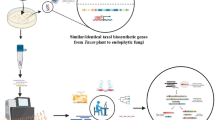Abstract
Triarimol and triforine inhibit ergosterol biosynthesis in fungi and cause accumulation of free fatty acids, 24-methylenedihydrolanosterol, obtusifoliol and 14α-methyl-δ8,24(28)-ergostadienol. Triparanol also inhibits ergosterol synthesis and causes accumulation of free fatty acids, but not of the latter 3 sterols. Triparanol appears to inhibit prior to lanosterol in the sterol biosynthetic pathway of Ustilago maydis and at unidentified sites subsequent to lanosterol which lead to the accumulation of a sterol which migrates with desmethylsterols on TLC plates. Quantitative abnormalities in sterols and free fatty acids in U. maydis are not produced by the fungicides carbendazim, chloroneb, carboxin and cycloheximide. A deficiency in nitrogen leads to a marked increase in triglycerides, but a normal distribution pattern for other lipids.
Inhibition of oxidative demethylation of the sterol 14α-methyl group is probably the prime mechanism of inhibition of ergosterol biosynthesis by triarimol. Rates of formation of obtusifoliol and 14α-methyl-δ8,24(28)-ergostadienol in triarimol-treated U. maydis cells suggest that C-4 demethylation occurs along an abnormal pathway which operates effectively only at high substrate concentrations. The growth retardant action of triarimol and ancymidol in higher plants most likely results from inhibition of a reaction in the gibberellin biosynthetic pathway analogous to sterol C-14 demethylation.
Free fatty acid accumulation in U. maydis cells treated with inhibitors of sterol synthesis are derived mainly from polar lipid degradation and from de novo synthesis as a consequence of the disproportionality between fatty acid synthesis and utilization. The free fatty acids may play a significant role in the lethality of these inhibitors in this organism.
Similar content being viewed by others
References
Akhtar, M., Watkinson, I.A., Rahimtula, A.D., Wilton, D.C. & Munday, K.A., 1969. The role of a cholesta-8,14-dien-3β-ol system in cholesterol biosynthesis. Biochem. J. 111: 757–761.
Coolbaugh, R.C. & Hamilton, R., 1976. Inhibition of ent-kaurene oxidation and growth by α-cyclopropyl-α-(p-methoxyphenyl)-5-pyrimidine methyl alcohol. Pl. Physiol., Lancaster 57: 245–248.
Gaylor, J.L., Miyake, Y. & Yamano, T., 1975. Stoichiometry of 4-methyl sterol oxidase of rat liver microsomes. J. biol. Chem. 250: 7159–7167.
Kato, T., Tanaka, S., Ueda, M. & Kawase, Y., 1975. Inhibition of sterol biosynthesis in Monilinia fructigena by the fungicide, S-1358. Agric. biol. Chem. 39: 169–174.
Leopold, A.C., 1971. Antagonism of some gibberellin actions by a substituted pyrimidine. Pl. Physiol., Lancaster 48: 537–540.
Ragsdale, N.N., 1975. Specific effects of triarimol on sterol biosynthesis in Ustilago maydis. Biochim. biophys. Acta 380: 81–96.
Ragsdale, N.N. & Sisler, H.D., 1973. Mode of action of triarimol in Ustilago maydis. Pestic. Biochem. Physiol. 3: 20–29.
Sherald, J.L., Ragsdale, N.N. & Sisler, H.D., 1973. Similarities between the systemic fungicides triforine and triarimol. Pestic. Sci. 4: 719–727.
Sherald, J.L. & Sisler, H.D., 1975. Antifungal mode of action of triforine. Pestic. Biochem. Physiol. 5: 477–488.
Shive, J.B. & Sisler, H.D., 1976. Effect of ancymidol (a growth retardant) and triarimol (a fungicide) on growth, sterols and gibberellins of Phaseolus vulgaris. Pl. Physiol., Lancaster 57: 640–644.
Williams, M.T., Gaylor, J.L. & Morris, H.P., 1976. Characterization of microsomal methyl sterol demethylases in two Morris hepatomas. Cancer Res. 36: 291–297.
Author information
Authors and Affiliations
Rights and permissions
About this article
Cite this article
Sisler, H.D., Ragsdale, N.N. Fungitoxicity and growth regulation involving aspects of lipid biosynthesis. Neth. J. Pl. Path. 83 (Suppl 1), 81–91 (1977). https://doi.org/10.1007/BF03041423
Issue Date:
DOI: https://doi.org/10.1007/BF03041423




